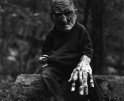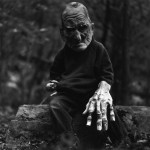Hiroshi Watanabe: Suo Sarumawashi
My longtime friend, Hiroshi Watanabe, opens an exhibition of his wonderful Suo Saruawashi project at the Kopeikin Gallery in Los Angeles, this Saturday, September 7th and runs through October 26th, 2013. I am enthralled by these portraits, and am the happy owner of the two images above. The photographs reflect a range of emotions, not only from the monkeys, but by the viewer.
Hiroshi was born in Sapporo, Japan. He graduated from Department of Photography, College of Art, at Nihon University. He moved to Los Angeles after graduation and became involved in the production of TV commercials, eventually working as a producer. He later established his own production company. He received an MBA degree from UCLA Business School in 1993. In 1995 his passion for photography rekindled, and since then he has traveled worldwide extensively, photographing what he finds intriguing at that moment and place. In 2000 he closed the production company in order to devote himself to the art and became a full time photographer.
Since then, his work has been exhibited and published in many parts of the world. His awards include International Photography Awards (2003), Black & White Spider Awards (2004, 2005), Photolucida Critical Mass Book Award (2006), Sagamihara Photo Award (2007), Santa Fe Center Project Competition First Prize (2008), and Hearst 8×10 Photography Biennial (2009). His work is in the collections of Philadelphia Museum of Art, Houston Museum of Fine Arts, George Eastman House, Santa Barbara Museum of Art, J. Paul Getty Museum, and San Jose Museum of Art.
His monographs include: I See Angels Every Day, Mado-sha, Japan 2007,Findings, Photolucida, USA 2007, Ideology in Paradise, Mado-sha, Japan 2008, Suo Sarumawashi, photo-eye Editions, USA 2009, Love Point, Toseisha, Japan 2010, Love Point, Nazraeli Press, USA 2011, 99 Findings, Hibiku, Japan 2012 and ARTIFACTS, Hibiku, Japan 2012.
When I grew up in Japan, Sarumawashi (direct translation: monkey circling, i.e. monkey dancing) was common thing to see on streets. They came on holidays and for festivals, but they also came randomly when there were no apparent reasons to celebrate. I was fascinated by the monkeys. Who wouldn’t be, when you are a child, by small creatures dressed like people doing tricks, dancing, and acting like small people? I stayed with them until my parent grabbed my hands and pull me away. Then, as I grew older, I forgot about them, or I just didn’t pay attention any more. They were disappearing anyway. It became thing of the past, and as a grown-up, it seemed cruel to make animals do things just to entertain us humans, I thought.
Last year, I spent months in Japan waiting for my baby’s arrival. As I was thinking about my son’s future life as a child, I started to think about my past life as a child. Then I remembered those monkeys and they somehow became a part of the pondering process. Nowadays, those monkeys exist in theaters which became popular attractions for families with children. People go see monkeys like they go to theme parks. I began to look at the
pictures of the theater monkeys and was amused how their expressions are like those of humans. I wondered, “Do they naturally have emotions and expressions like humans, or were they simply trained to make faces to mimic our facial expressions?“
I remember going to the Bronx Zoo in New York several years ago. Their so-called Congo Gorilla Forest is set up for mountain gorillas to move around in the safari-like acres and people can watch them closely from a room below, separated only by thick sheets of glass. There I spent hours watching and studying the gorillas’ facial expressions. They showed a lot of affections for each other, and I was amazed how expressive those gorillas were. After that experience, I had no doubt that those primates have the same intricate and subtle feelings and emotions like people. So, I wondered, “Are the monkeys like the gorillas I saw and are they really feeling like us?”
I remember going to the Bronx Zoo in New York several years ago. Their so-called Congo Gorilla Forest is
set up for mountain gorillas to move around in the safari-like acres and people can watch them closely from a room below, separated only by thick sheets of glass. There I spent hours watching and studying the gorillas’ facial expressions. They showed a lot of affections for each other, and I was amazed how expressive those gorillas were. After that experience, I had no doubt that those primates have the same intricate and subtle feelings and emotions like people. So, I wondered, “Are the monkeys like the gorillas I saw and are they really feeling like us?”
I decided to go and see the monkeys. I wrote to the Suo Sarumawashi Association and asked for permission to photograph the monkeys. The answer came back with “yes”. The association operates two theaters—one at the base of Mt. Fuji and the other at the base of Mt. Aso (active volcano) in Kumamoto Prefecture in southern Japan. I visited both of them and all day long I photographed the monkeys between their stage appearances. For the camera, the monkeys stood up straight and struck the poses for the plays over and over. But after a while, they started to fall back to their own inner-self, revealing their true personalities, but it only lasted until the trainers said something, and the monkeys immediately corrected the posture.
There’s always one trainer to one monkey. In other words, they work as a couple and trainers do not handle more than one monkey at any given time. They spend many hours practicing and appear on the stage together every day. This one to one relationship last until the day when the monkey retires (monkeys retire after several years of performing and afterwards live and are taken care of among other monkeys till natural death). They rely on each other and their bondage must be strong. The first and most important training is to stand up on two feet—being bipedal like humans. It must be so hard for monkeys to become bipedal, but every monkey I met seems to do it easily as if it is natural for them. But when they are done with photo sessions, they started to walk on their hands, as if revealing it was just a job to do. One thing I found interesting was that all those monkeys were born wild in the mountains. The association obtains special permit to capture small number of monkeys when need new monkeys. The monkeys must be about one year old. They said they have tried with monkeys born and raised by humans, but those monkeys wee too spoiled and they did not have “guts” to tolerate the rigor of the training.
Now, going back to the original question, “Do those monkeys have feelings and emotions like us humans?” My answer will be definitely yes–just look at the pictures.
Posts on Lenscratch may not be reproduced without the permission of the Lenscratch staff and the photographer.
Recommended
-
Martin Stranka: All My StrangersDecember 14th, 2025
-
The Family Album of Ralph Eugene Meatyard at the High MuseumDecember 10th, 2025
-
Paccarik Orue: El MuquiDecember 9th, 2025
-
Richard Renaldi: Billions ServedDecember 6th, 2025
-
The Art of Documentary Photography: Rania MatarOctober 25th, 2025






























































